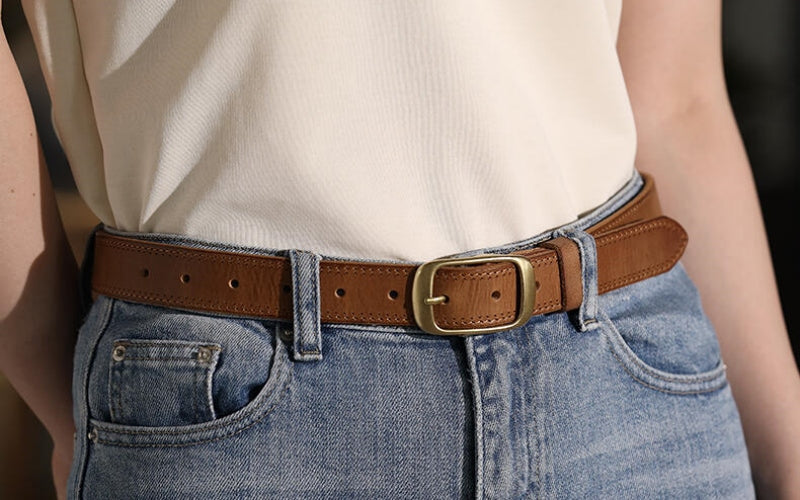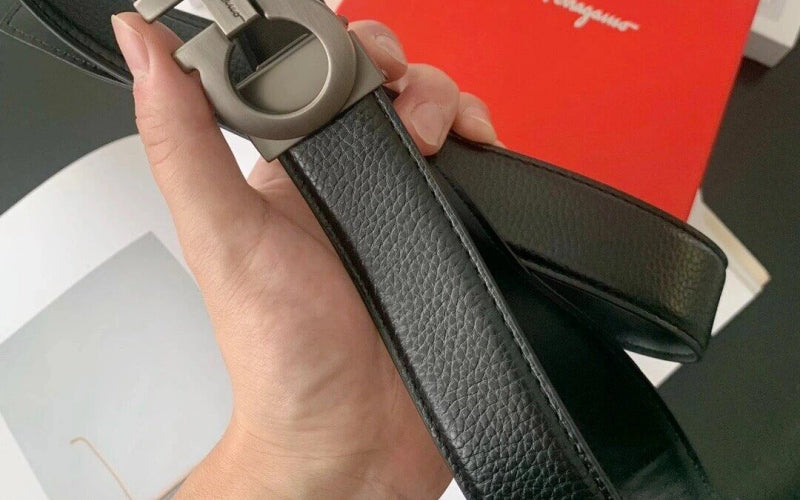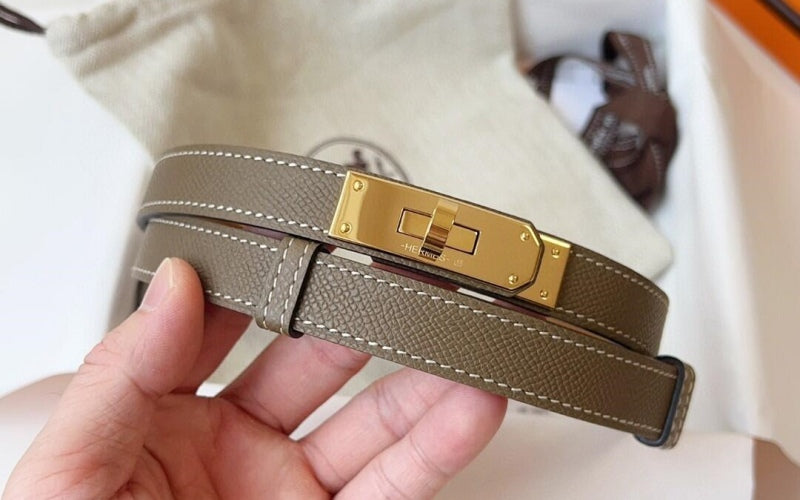
Why Are Belts Made of Leather? (Detailed Answers By BELTLEYl)
Let’s start with a hard truth: the world is full of belts made from nylon, plastic, and even recycled soda cans. Yet, when you think of a real belt—the kind that pairs with a tailored suit or your favorite jeans—you picture leather. Why? Is it tradition? Snobbery? Or is there something magical about dead cowhide that makes it the MVP of waistbands?
Grab a coffee (or something stronger), because we’re diving into the history, science, and cultural obsession behind leather belts.
By the end, you’ll understand why your grandpa’s 40-year-old leather belt outlived his third marriage, and why Beltley’s full-grain leather belts are worth every penny.
 Tired of belts giving up? Get a leather belt built to last — click here.
Tired of belts giving up? Get a leather belt built to last — click here.
1. The Ancient Art of Holding Up Pants: A History of Leather Belts
Leather belts are older than the wheel, taxes, and your weird uncle’s conspiracy theories. Let’s time-travel:
A. Cavemen & Early Practicality (20,000 BCE)
-
The First Belts: Strips of animal hide used to secure tools, weapons, and loincloths (RIP dignity).
-
Symbolism: Belts denoted status. A clean pelt = “I’m a great hunter.” A ragged one = “I’m bad at spears.”
B. Ancient Civilizations: Egypt, Rome & Beyond
-
Egyptians: Used leather belts with gold buckles in burials. Because even the afterlife requires a sharp outfit.
-
Roman Soldiers: Wore cingulum militare belts to hold armor and swords. Lose your belt? Face a demotion (or a decapitation).
C. Middle Ages to Modernity
-
Knights & Nobility: Tooled leather belts displayed family crests. Peasants? They got rope.
-
Industrial Revolution: Mass production made leather belts accessible. Finally, commoners could cinch their pants like kings!
Fun Fact: The term “belt and braces” (being overly cautious) comes from 1800s workers who wore both belts and suspenders. Trust issues, much?

Tired of belts giving up? Get a leather belt built to last — click here.
2. The Science of Leather: Why It’s Nature’s Perfect Material
Leather isn’t just “skin”—it’s a biological marvel. Here’s why:
A. Molecular Structure
-
Collagen Fibers: Leather’s backbone. Tightly woven = durable; loosely woven = flexible.
-
Hydrophobic & Hydrophilic Zones: Repels water and absorbs conditioning oils. Basically, it’s a self-care guru.
B. Physical Properties
-
Tensile Strength: Leather can withstand 3,000 psi of pressure. Your car tires? 32 psi.
-
Flexibility: Bends without breaking, unlike your resolve on a diet.
-
Breathability: Lets moisture escape, preventing swampy waist syndrome (take notes, nylon).
Pro Tip: Full-grain leather (Beltley’s specialty) retains all these natural properties. “Genuine leather” is the diet soda of hides—watered down and sad.
 Tired of belts giving up? Get a leather belt built to last — click here.
Tired of belts giving up? Get a leather belt built to last — click here.
3. Leather vs. the World: Why Other Materials Don’t Stand a Chance
Let’s pit leather against its wannabe rivals:
A. Synthetic Belts (Plastic, PVC, Vegan Leather)
-
Pros: Cheap, cruelty-free (sometimes).
-
Cons:
-
Cracks & Peels: Like a bad sunburn after two summers.
-
Sweaty Back: Traps moisture like a Ziploc bag.
-
Eco-Fraud: Most “vegan leather” is plastic. Congrats, you’re wearing a fossil fuel.
B. Fabric Belts (Nylon, Canvas)
-
Pros: Lightweight, colorful.
-
Cons:
-
Stretches Out: Becomes floppier than a wet noodle.
-
Frays & Fades: Loses its looks faster than a TikTok trend.
C. Metal Belts (Chain, Buckle-Only)
-
Pros: Edgy, statement-making.
-
Cons:
-
Weight: Feels like wearing a barbell.
-
Bruising: Say hello to hip divots.
Verdict: Leather is the Goldilocks of belts—just right.
 Tired of belts giving up? Get a leather belt built to last — click here.
Tired of belts giving up? Get a leather belt built to last — click here.
4. The Leather Hierarchy: Which Type is King?
Not all leather is created equal. Let’s break it down:
A. Full-Grain Leather
-
What It Is: The top layer of hide, untouched.
-
Pros: Durable, ages beautifully, breathable.
-
Beltley’s Choice: Our belts use full-grain Italian leather. It’s the Tom Hardy of materials—ruggedly handsome.
B. Top-Grain Leather
-
What It Is: Sanded to remove imperfections.
-
Pros: Softer, cheaper.
-
Cons: Less durable. Like a sports car with a weak engine.
C. Genuine Leather
-
What It Is: The leftover scraps glued together.
-
Pros: Affordable.
-
Cons: Peels, cracks, and disappoints. The participation trophy of leather.
D. Exotic Leathers (Alligator, Ostrich)
-
Pros: Luxe, unique textures.
-
Cons: Pricey, ethically iffy.
Pro Tip: Always ask, “Is this full-grain?” If the seller hesitates, run.
 Tired of belts giving up? Get a leather belt built to last — click here.
Tired of belts giving up? Get a leather belt built to last — click here.
5. The Craftsmanship Chronicles: How Leather Belts Are Born
Turning hide into a belt is an art form. Here’s how Beltley does it:
Step 1: Selecting the Hide
-
Source: Ethically raised cattle (no stressed hides = fewer imperfections).
-
Inspection: Only 1 in 10 hides makes the cut. The rest become couches.
Step 2: Tanning (The Spa Treatment)
-
Vegetable Tanning: Uses tree bark. Eco-friendly, slow (4 weeks).
-
Chrome Tanning: Uses chemicals. Fast (1 day), less eco-friendly.
Beltley’s Method: Vegetable-tanned for Mother Earth approval.
Step 3: Cutting & Stitching
-
Cutting: Laser precision. No jagged edges.
-
Stitching: Double-needle saddle stitching. If one thread breaks, the rest hold.
Step 4: Buckle Attachment
-
Solid Brass Rivets: Won’t snap like plastic.
-
Hand-Polished Buckles: Shiny enough to check your teeth in.

Tired of belts giving up? Get a leather belt built to last — click here.
6. The Environmental Elephant in the Room
Leather gets flak for environmental impact. Let’s unpack:
A. The Case Against Leather
-
Livestock Emissions: Cows = methane factories.
-
Chemical Runoff: Cheap tanning pollutes water.
B. The Case For Leather
-
Byproduct Use: Leather uses hides that’d otherwise be trashed.
-
Longevity: A leather belt lasts decades; synthetics last months.
-
Beltley’s Ethics: We use eco-tanned leather and support reforestation.
Pro Tip: Buy quality, buy less. Fast fashion is the real villain.

Tired of belts giving up? Get a leather belt built to last — click here.
7. Leather Belt Care: How to Make It Outlive Your Cat
A Beltley belt can last 20+ years—if you treat it right:
A. Cleaning
-
Weekly: Wipe with a damp cloth.
-
Monthly: Use leather soap for deep cleans.
B. Conditioning
-
Every 6 Months: Massage in leather conditioner (Beltley’s is pH-balanced).
-
Avoid: Olive oil. It’s for salads, not belts.
C. Storage
-
Hang or Coil: No kinks, no folds.
-
Avoid: Sunlight, heat vents, and your dog’s chewing radius.

Tired of belts giving up? Get a leather belt built to last — click here.
8. Debunking Leather Myths
Myth 1: “Leather is Cruel.”
-
Truth: Most leather is a byproduct of the meat industry. No cows die just for belts.
Myth 2: “Vegan Leather is Better.”
-
Truth: 95% is plastic. Cute for shoes, terrible for landfills.
Myth 3: “Leather is High-Maintenance.”
-
Truth: Conditioning takes 5 minutes twice a year. Less effort than your Tinder profile.
9. FAQs: Your Leather Queries, Solved
Q: How long does a leather belt last?
A: A Beltley belt? Decades. Cheap leather? Maybe a Netflix binge cycle.
Q: Can I get my belt wet?
A: Light rain = fine. Monsoons = pat dry and condition.
Q: Why does leather crack?
A: Lack of conditioning. Moisturize it like your Tinder date’s ego.
Q: Are leather belts adjustable?
A: Yes! Add holes with a punch (or visit a cobbler).
10. Why Beltley Belts Are Worth the Splurge
-
Quality: Full-grain Italian leather that ages like a Hollywood star.
-
Craftsmanship: Hand-stitched, reinforced, and built for your grandkids.
-
Ethics: Sustainable practices, because we like polar bears.
Translation: You’re not buying a belt. You’re buying a legacy.
11. The Final Word: Leather Belts Are Forever
Leather belts aren’t a trend—they’re a testament to human ingenuity. From ancient warriors to modern CEOs, we’ve trusted leather to hold our lives together (literally). So, next time you buckle up, remember: You’re wearing history, science, and a little bit of magic.
PS: Ready to join the leather legacy? Explore Beltley’s Collection—where every belt is a promise of quality, and no cows were harmed for your dad jokes.

